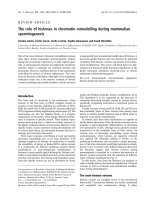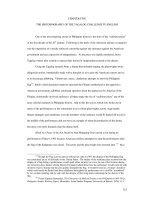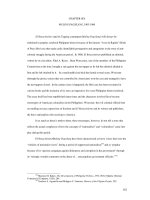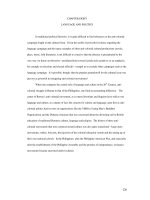Influence of different packaging materials on occurrence of pathogens in pear fruit during storage
Bạn đang xem bản rút gọn của tài liệu. Xem và tải ngay bản đầy đủ của tài liệu tại đây (353.11 KB, 7 trang )
Int.J.Curr.Microbiol.App.Sci (2018) 7(3): 1609-1615
International Journal of Current Microbiology and Applied Sciences
ISSN: 2319-7706 Volume 7 Number 03 (2018)
Journal homepage:
Original Research Article
/>
Influence of Different Packaging Materials on Occurrence of Pathogens in
Pear Fruit during Storage
Vikram Singh*, O.P. Dudi, J.K. Sandooja and R.K. Goyal
Chaudhary Charan Singh Haryana Agricultural University, Hisar-125004, Haryana, India
*Corresponding author
ABSTRACT
Keywords
Pear, Polyethylene,
Corrugated fiber board boxes,
Patharnakh, Kashmirinakh,
Baggugosha, Zero Energy
Chamber
Article Info
Accepted:
12 February 2018
Available Online:
10 March 2018
The present study aimed at enhancing the shelf life of pear fruits. The fruits of pear
varieties namely Patharnakh, Kashmirinakh and Baggugosha were stored under zero
energy cool chamber (ZECC) storage using different types of packaging materials i.e.
corrugated fiber board boxes (CFB), individual fruit packing and in 1 kg packing in
polyethylene (PE) bags of 0.01 mm and 0.05 mm thickness. Irrespective of the treatments,
a continuous decrease in specific gravity of the fruits was observed with the lapse of time.
Of the three varieties, the Patharnakh fruits had maximum shelf life. Individual packing of
fruits in polyethylene bags of 0.01 mm and storage under ZECC proved to be most
effective treatment in checking the decay loss. Whereas, the maximum degradation of
fruits was found in CFB boxes stored at room temperature. Therefore, ZECC storage with
suitable packaging material has great prospects in hot regions for short term preservation
of fruits soon after harvest.
Introduction
Pear (Pyrus communis L.) is a member of
family Rosaceae and is just next to apple in
terms of importance, acreage, production and
varietal diversity among different temperate
fruits in India. Pear is a fruit of temperate
habitat but some low chilling pear varieties
like
Patharnakh,
Kashmirinakh
and
Baggugosha have also enabled its cultivation
in the subtropical regions of Punjab and
Haryana states.
The hot temperature in the months of JulyAugust triggers rapid ripening of fruits which
also reduces the shelf life of pear fruit and is a
serious constraint in their efficient handling
and transportation. Polythene bags create a
modified atmospheric condition inside the
package, which lowers down the concentration
of O2 and increases the concentration of CO2.
The modified gaseous composition of the
package helps in slowing down the
physiological processes like respiration and
transpiration, reduces the physiological loss of
fruit weight and helps in maintaining the
freshness of fruits for longer period of time.
Refrigerated cold storage is considered to be
the best method for storage of fruits and
vegetables. However, this method is highly
energy intensive, requires large initial capital
investment and is also not suitable for on-farm
storage in the rural areas. Considering the
1609
Int.J.Curr.Microbiol.App.Sci (2018) 7(3): 1609-1615
acute energy shortage in rural areas, the low
cost, on-farm scientific storage structures like
zero energy cool chamber (ZECC) has better
use potential. The ZECC was devised at IARI
by Roy and Khurdia (1986) which works on
the principle of evaporative cooling. The
structure is built from easily available low cost
materials like brick, sand, khaskhas, bamboo,
gunny bags etc.
The ZECC due to evaporative cooling helps in
maintaining the inside temperature 8 to 10°C
lower than the outside environment and
maintains relative humidity nearly 90-95 per
cent. The ZECC have been found successful
for enhancing the storage life of Kinnow (Pal
et al., 1997) and banana (Mustaffa et al.,
2005). Hitherto, no systematic work has been
done in pear to enhance shelf life of fruits
using ZECC and different types of packaging
materials. So, the purpose of conducting this
experiment was to investigate the influence of
different packaging materials on pear varieties
under ZECC.
Materials and Methods
The experiment was conducted in the PostHarvest
Laboratory,
Department
of
Horticulture, Chaudary Charan Singh Haryana
Agricultural University (CCS HAU), Hisar.
The fruits of the three varieties viz.
Patharnakh, Baggugosha and Kashmirinakh
were harvested at maturity with the help of a
secateur. Then fruits were packed in the
corrugated fiber board (CFB) boxes of 2 kg
capacity using newspapers as cushioning
material (control), polyethylenes of individual
fruit packing (IFP) and 1 kg capacity bags of
0.01mm and 0.05 mm thickness.
The half of the packed fruits were stored at
ambient temperature(32±4°C and R.H. 7075%), while the remaining half stored in
ZECC of storage dimensions 195 x 135 x 67.5
cm for 10 days. The floor of ZECC was made
up of a single layer of bricks, the side walls
with a double layer of bricks, the space (7.5
cm) in between the bricks was filled with
sand. The top of storage space was covered
with wet gunny bags in bamboo structure.
Sprinkling of water twice a day was enough to
maintain the low temperature and high
humidity (23.2±3°C and R.H. 90-95%). All
the treatments were replicated four times
taking each box as one replication.
Observations
The data on loss due to decay were recorded
in the fruits taken from replication 1 to 3 on
2nd,4th,6th,8th and 10th day of storage.
During storage, the fruits showing rotting
symptoms due to over ripening and
pathological infection were considered
decayed. The per cent decay loss was worked
out by the following formula:
Weight of decayed fruits
Decay Loss (%) = ------------------------- X 100
Initial weight of fruit at the time of packing
The decay causing organisms were identified
with the collaboration of the Department of
Plant Pathology CCS HAU Hisar.
The data on parameter of specific gravity of
the fruits were recorded on 3 fruits randomly
picked from 4th replication on every alternate
day.
The specific gravity was recorded through
water displacement method and was
calculated by using the following formula:
Density of fruit
Specific gravity = ---------------------Density of water
The density of fruits in g cm-3 was worked out
by the weight of the fruits to their volume.
1610
Int.J.Curr.Microbiol.App.Sci (2018) 7(3): 1609-1615
Statistical analysis
The experiment was laid out in a Complete
Randomized Design (CRD) and treatments
were compared using ANOVA procedure at 5
per cent level of significance.
Results and Discussion
Decay loss
At the end of the storage, the minimum decay
loss in Patharnakh (18.16%) and Baggughosa
(20.07and 20.12 %) were observed in the
treatments of individual fruits packed in PE
(0.01 and 0.05 mm) bags and stored in ZECC
(Table 1). On the other hand, the minimum
loss due to decay in Kashmirinakh was
observed in the 1 kg fruits packed in PE (0.05
mm) bags stored at room temperature and at
par with PE 0.01mm at ZECC. The maximum
decay loss (32.14%) was noticed in variety
Baggugosha packed in CFB boxes at room
temperature (control).
Irrespective of the treatment, the decay
associated loss increased in all varieties with
the advancement of storage period. This may
be due to exposure of fruits to micro-floras
during storage.
The condensation of moisture on the surface
of fruits, storage humidity due to transpiration,
anaerobic condition and breakdown of
enzymes etc. help in multiplication of micro
flora. The increase in decay loss during
prolonged storage is in agreement with the
earlier findings of Nath et al., (2012) and Kaur
et al., (2013) in pear and Mahajan et al.,
(2015) in peach.
Comparatively lower decay loss under
polyethylene packing than CFB boxes can be
attributed to the isolation of fruits from the
open
environment
and
only
few
microorganisms could diffuse into the
polybags. On the other hand the fruits were
fully exposed to the microflora in CFB boxes.
Similar decrease in decay with use of
polythene bags has also been reported by Kaur
et al., (2013). Further, the fruits of variety
Baggugosha were found more prone to decay
loss as compare to Patharnakh. Whereas,
Kasmirinakh fruits in PE 0.05 mm of 1 kg bag
stored at room temperature and PE 0.01 mm
of 1kg bag at ZECC showed lower decay loss
and that could be due to better suitability of
these films in vapour transmission and
gaseous exchange for Kashmirinakh fruits.
Specific gravity
A decreasing trend in specific gravity was
seen during storage of 10 days in all the
varieties irrespective of treatments (Table 2).
The effect of packaging materials on specific
gravity of Patharnakh and Kashmirinakh fruits
was found non-significant.
However, in case of Baggugosha maximum
specific gravity on 10th day of storage (1.034)
was observed in individual fruits packed in PE
bags of 0.01 mm and stored in zero energy
cool chamber.
Polyethylene packed fruits retained higher
specific gravity as compare to CFB boxes.
This may be due to lower PLW in polythene
packed fruits as compare to control i.e. CFB
boxes.
Decrease in specific gravity during storage
may be correlated with decrease in fruit
weight.
Arya (2001) also reported decreasing trend of
specific gravity in Kinnow Mandrin. Specific
gravity of Patharnakh and Kashmirinakh fruits
was higher than Baggugosha, which could be
correlated with lower weight loss in these
varieties as compared to Baggugosha.
1611
Int.J.Curr.Microbiol.App.Sci (2018) 7(3): 1609-1615
Table.1 Effect of packaging materials on decay loss (%) during storage of pear at room temperature and zero energy chamber
Sr.
No
Treatments
Patharnakh
Kashmirinakh
Days after storage
2
4
Baggugosha
Days after storage
6
8
10
2
4
Days after storage
6
8
10
2
4
6
8
10
1.
CFBboxesRoom(Control)
5.17
8.32
12.19
18.55
24.10
5.74
8.77
12.98
19.63
27.42
6.90
9.02
14.21
22.17
32.14
2.
CFBZEC
4.70
7.65
10.31
15.73
21.62
5.10
7.91
11.86
17.34
24.31
5.32
8.76
12.65
19.72
26.10
3.
PE0.01 mm(IFP)Room
3.54
5.66
8.85
13.80
18.33
3.82
5.89
10.15
16.29
21.26
4.38
6.67
10.51
17.22
23.44
4.
PE0.01 mm(IFP)ZEC
2.94
5.41
8.52
13.20
18.16
2.26
4.42
9.18
15.74
19.68
4.29
5.22
9.14
13.26
20.12
5.
PE0.05 mm(IFP)Room
3.25
5.59
8.46
12.78
19.25
3.70
5.70
10.72
13.90
20.10
5.76
6.38
9.44
15.61
22.10
6.
PE0.05 mm(IFP)ZEC
2.90
5.26
8.30
12.69
18.20
3.34
5.07
10.68
14.12
20.21
4.20
6.77
8.96
14.93
20.07
7.
PE0.01 mm(1 kgbag)Room
3.17
6.75
9.40
13.57
19.41
3.63
4.96
11.83
14.04
21.15
5.06
6.92
10.33
15.25
22.31
8.
PE0.01 mm(1 kgbag)ZEC
2.91
6.62
9.08
13.45
19.22
2.32
4.46
10.08
15.28
19.23
5.25
7.13
11.08
14.69
20.98
9.
PE0.05mm(1 kgbag)Room
3.22
5.34
9.15
13.50
19.28
2.56
4.38
11.06
14.10
19.14
4.80
5.61
11.26
14.23
21.09
10.
PE0.05 mm(1kgbag)ZEC
3.10
5.27
8.91
13.37
19.06
2.20
4.21
10.90
16.33
20.49
4.09
5.35
9.05
14.07
20.95
CD at 5%
Mean
Overall mean for
Room
ZEC
CD at 5% Room
0.09
0.09
0.26
NS
0.09
0.14
0.13
0.41
0.13
0.17
0.33
0.33
0.28
1.58
0.77
3.49
6.19
9.32
14.06
19.66
3.47
5.58
10.94
15.68
21.30
5.01
6.78
10.66
16.12
22.93
14.44
13.69
20.07
19.25
11.35
10.54
15.59
15.76
21.81
20.78
16.90
15.33
24.22
21.64
3.67
3.31
6.33
6.04
9.61
9.02
2.75
Storage
NS
3.89
3.04
5.94
5.21
5.38
4.63
6.92
6.65
ZEC
0.21
CFB = Corrugated fibre board boxes, Room = Room temperature, IFP = Individual Fruit Packing, PE = Polyethylene, ZEC = Zero Energy Chamber
1612
11.15
10.18
Int.J.Curr.Microbiol.App.Sci (2018) 7(3): 1609-1615
Table.2 Effect of packaging materials on specific gravity during storage of pear at room temperature and zero energy chamber
Sr.
No.
Treatments
Varieties
Kashmirinakh
Patharnakh
1.027
0
1.082
Days after storage
2
4
6
8
1.068 1.035 1.020 0.996
10
0.980
0.988
0.991
1.028
1.037
1.080
1.079
1.076
1.064
1.040
1.048
1.026
1.030
0.997
0.998
1.000
0.992
1.039
1.077
1.067
1.041
1.033
1.018
0.997
0.990
1.037
1.088
1.066
1.047
1.040
1.020
0.995
0.993
1.035
1.078
1.066
1.069
1.066
1.025
1.008
0.995
1.041
1.080
1.089
1.052
1.051
1.023
1.011
0.997
1.037
1.087
1.062
1.050
1.021
1.008
0.989
1.089
1.088
1.043
1.017
0.997
0.993
1.086
1.068
1.049
1.018
1.000
Room
ZEC
1.085
1.087
1.066
1.070
1.053
1.045
1.019
1.017
Storage
Variety
CD at 5%
1.077
1.035
1.065
1.035
1.045
1.028
1.021
CFB boxes Room
(Control)
CFB ZEC
2.
PE 0.01 mm (IFP)
3.
Room
PE 0.01 mm(IFP)
4.
ZEC
PE 0.05 mm (IFP)
5.
Room
PE 0.05 mm (IFP)
6.
ZEC
PE 0.01 mm
7.
(1 kg bag) Room
PE 0.01 mm (1 kg
8.
bag) ZEC
PE 0.05mm
9.
(1 kg bag) Room
PE 0.05 mm
10.
(1kg bag) ZEC
Overall Mean for
1.
0
1.085
Days after storage
2
4
6
8
1.060 1.035 1.004 0.990
10
0.986
1.082
1.084
1.052
1.060
1.041
1.060
1.010
1.029
0.994
0.998
1.088
1.087
1.052
1.013
1.086
1.080
1.052
1.087
1.072
1.085
Storage
Variety
Packaging
0.006
0.004
NS
Room
0.009
ZEC
0.027
SxP
SxV
VxP
SxVxP
1.030
Days after storage
2
4
6
8
1.056 1.032 0.998 0.990
10
0.981
1.021
1.026
0.983
0.986
1.034
1.034
1.067
1.067
1.063
1.061
1.038
1.049
1.015
1.020
0.997
0.997
0.984
0.986
1.027
1.030
1.030
1.034
1.008
0.989
1.036
1.069
1.068
1.053
1.027
1.004
0.983
1.034
1.036
1.031
0.997
0.982
1.035
1.068
1.060
1.046
1.030
0.998
0.985
1.031
1.034
1.052
1.038
1.006
0.985
1.038
1.070
1.067
1.037
1.026
1.008
0.992
1.033
1.035
1.077
1.056
1.030
0.997
0.988
1.038
1.066
1.055
1.033
1.012
0.992
0.982
1.023
1.034
1.077
1.062
1.045
1.037
1.000
0.990
1.035
1.065
1.063
1.036
0.999
0.996
0.984
1.024
1.032
1.036
1.075
1.058
1.040
1.024
1.004
0.992
1.032
1.069
1.053
1.034
1.009
0.997
0.986
1.025
1.031
1.038
1.076
1.061
1.046
1.029
1.008
0.995
1.036
1.068
1.064
1.040
1.016
1.002
0.990
1.030
1.035
0.991
1.079
1.067
1.045
1.030
1.001
0.987
1.068
1.061
1.040
1.015
0.998
0.985
1.000
0.999
0.990
0.993
1.081
1.078
1.067
1.066
1.045
1.045
1.027
1.033
0.998
1.004
0.986
0.998
1.068
1.068
1.057
1.065
1.039
1.041
1.014
1.017
0.995
1.001
0.984
0.987
1.000
0.988
CFB
IFP
ZEC
PE
Room
Mean
Over
Mean
0
1.068
NS
NS
NS
NS
Mean
Baggugosha
Corrugated fibre board boxes
Individual fruit packing
Zero energy chamber
Polyethylene
Room temperature
1613
CD at 5% for
Packaging
Patharnakh
NS
Kashmirinakh NS
Baggugosha
0.008
Mean
all
Int.J.Curr.Microbiol.App.Sci (2018) 7(3): 1609-1615
Table.3 Effect of packaging materials on occurrence of pathogens during storage of pear
at room temperature and zero energy chamber
Sr.
No.
Treatments
Patharnakh
Kashmirinakh
Baggugosha
Days after storage
Days after storage
Days after storage
2
4
6
8
10
2
4
6
8
10
2
4
6
8
10
1.
CFBboxesRoom(Control)
PPB
PPB
PPB
PPB
PPB
PPB
PPB
PPB
PPB
PPB
PPB
PPB
PPB
PPB
PPB
2.
CFBZEC
PPB
PPB
PPB
PPB
PPB
PPB
PPB
PPB
PPB
PPB
PPB
PPB
PPB
PPB
PPB
3.
PE0.01 mm(IFP)Room
P
PB
PB
PPB
PPB
PB
PB
PPB
PPB
PPB
PB
PPB
PPB
PPB
PPB
4.
PE0.01 mm(IFP)ZEC
P
PB
PB
PB
PPB
PB
PB
PPB
PPB
PPB
PB
PPB
PPB
PPB
PPB
5.
PE0.05 mm(IFP)Room
P
PB
PB
PPB
PPB
PB
PB
PPB
PPB
PPB
PB
PPB
PPB
PPB
PPB
6.
PE0.05 mm(IFP)ZEC
P
PB
PB
PB
PPB
PB
PB
PPB
PPB
PPB
PB
PPB
PPB
PPB
PPB
7.
PE0.01 mm(1 kgbag)Room
P
PB
PB
PPB
PPB
PB
PB
PPB
PPB
PPB
PB
PPB
PPB
PPB
PPB
8.
PE0.01 mm(1 kgbag)ZEC
P
PB
PB
PPB
PPB
PB
PB
PPB
PPB
PPB
PB
PPB
PPB
PPB
PPB
9.
PE0.05mm(1 kgbag)Room
P
PB
PB
PPB
PPB
PB
PB
PPB
PPB
PPB
PB
PPB
PPB
PPB
PPB
10.
PE0.05 mm(1kgbag)ZEC
P
PB
PB
PPB
PPB
PB
PB
PPB
PPB
PPB
PB
PPB
PPB
PPB
PPB
P = Penicillium sp.
P = Physalospora sp.
CFB = Corrugated fibre board boxes
IFP = Individual fruit packing
B = Botrytis sp.
ZEC = Zero Energy Chamber
Room
PE = Polyethylene
1614
= Room temperature
Int.J.Curr.Microbiol.App.Sci (2018) 7(3): 1609-1615
Pathological observations
Fruits of all the varieties were found infected
with Penicillium sp., Physalospora sp. and
Botrytis sp. Low incidence of pathogens was
observed in PE 0.01 mm and PE 0.05 mm of
individual fruit packing at zero energy
chamber storage. Whereas, aggravated host
pathogen complex was found in CFB boxes at
room temperature as well as at zero energy
chamber storage (Table 3).
The results are in accordance with reports of
Logrieco et al., (2003), Baszczyk and Buczek
(2004) and Lennox and Spotts (2004) on
various fungi responsible for decay in pear
fruits during storage. This might be due to the
reason that fruits are living entities and
contain sufficient stored food material and are
exposed to various micro flora during storage.
References
Arya, Tejbir; 2001. Studies on the effect of
different packaging materials on shelf
life of Kinnow Mandarin. M.Sc Thesis,
CCS Haryana Agricultural University,
Hisar, India.
Baszczyk, J. and Buczek, M. 2004. Study on
the occurrence of fungal diseases in
pear during cold storage. Folia
Universitatis Agriculturae Stetinensis,
Agricultura, 96: 29-32.
Kaur, Kirandeep; Dhillon, W.S. and Mahajan
B.V.C. 2013. Feb. Effect of different
packaging materials and storage
intervals on physical and biochemical
characteristics of pear. J Food Sci.
Technol., 50(1):147-152.
Lennox, C.L. and Spotts, R.A. 2004. Timing
of pre-harvest infection of pear fruit by
Botrytis cinerea and the relationship to
post-harvest decay. Plant Disease, 88
(5): 468-473.
Logrieco, A., Bottalico, A., Mule, G., Moretti,
A. and Perrone, G. 2003. Epidemiology
of toxigenic fungi and their associated
mycotoxins for some Mediterranean
crops. European Journal of Plant
Pathology, 109 (7): 645-667.
Mahajan, B.V.C., Dhillon, W. S., Kumar,
Mahesh and Singh, Bikramjit. June
2015.Effect of different packaging films
on shelf life and quality of peach under
super and ordinary market conditions. J.
Food Sci. Technol., 52(6):3756-3762.
Mustaffa, M.M.,
Tanuja, P.B.
and
Krishnamoorthy,
V.,
2005.
Standardization of carrier material as
ethylene absorbent on shelf life of
‘Rusthali’ banana. J. Food Sci.
Technol., Mysore; 42(1):104-106
Nath, A., Deka C. Bidyut; Singh, Akath;
Patel, R.K., Paul D., Misra, L.K. and
Ojha, H. 2012 Oct. Extension of shelf
life of pear fruits using different
packaging materials. J. Food Sci.
Technol., 49(5):556-563.
Pal, R.K., Roy, S.K. and Srivastava, S.
1997.Storage performance of ‘Kinnow`
Mandarins
in
evaporative
cool
chambers and ambient condition. J.
Food Sc. Technol., 34(3):200-203.
Roy, S.K. and Khurdiya, D.S. 1986. Studies
on evaporatively cooled zero energy
input cool chambers for the storage of
horticultural produce. Ind. Fd. Packer;
40:26-31.
How to cite this article:
Vikram Singh, O.P. Dudi, J.K. Sandooja and Goyal, R.K. 2018. Influence of Different
Packaging Materials on Occurrence of Pathogens in Pear Fruit during Storage.
Int.J.Curr.Microbiol.App.Sci. 7(03): 1609-1615. doi: />
1615









